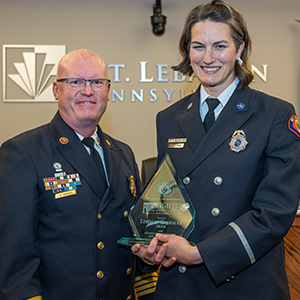Streamlined design for new fire engine

Leaders in the Mt. Lebanon Fire Department had one thing on their minds when designing the latest engine that made its debut this summer: Simplicity.
The 2023 Pierce Manufacturing custom-built fire engine has a classic look and offers versatility, while meeting the needs of Mt. Lebanon firefighters.
“We went back to the basics. We asked ourselves, ‘What is the engine used for most frequently?’ It’s just the basic, most simple stuff,” said Lt. Steve Quatchak, head of the apparatus committee.
The Mt. Lebanon Fire Department fleet includes three engines—the vehicles that respond to 90 percent of the calls—along with a ladder truck that is used for large commercial fires and a rescue vehicle that houses equipment, but carries no water. The department replaces an engine every five years.
The newest engine is the one that goes out on the majority of calls. When it is replaced, it gets bumped down the ladder (pun intended) until it has been with the department for 15 years. Then it’s sold and the money is used to help offset the cost of a new vehicle. The latest engine cost about $600,000 and is funded through the municipality and money from the volunteer fire company.
Every five years, the department forms a committee to design a new engine. With supply chain delays, it took two and a half years, from start to finish, to get the latest engine to Mt. Lebanon. Every aspect of the engine was custom designed to meet the department’s needs.
“The basic premise was just to be a little bit simpler,” Quatchak said. “This is a very traditional-style fire truck.”
Ergonomically, the engine was designed to be easier to drive. It’s lower to the ground and shorter in length, which allows it to make sharper turns.
Mounting ladders on the side of the truck allows for faster and easier access than those stored in an automated compartment on top of a vehicle.
The truck has three water intake valves—one on each side and one in the front—to make getting water from hydrants and from other engines easier. The department’s older engines have just one or two valves. Fire hoses in the back simply require the tug of a quick-release strap, again saving precious time.
The engine holds 500 gallons of water, and large, brightly lit gauges on the back and both sides of the engine make it easy for firefighters to tell from a distance how much water is left.
The hope is that this vehicle will become the model for Mt. Lebanon’s engines in the future, as redesigns will be minimal for future purchases.





